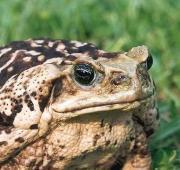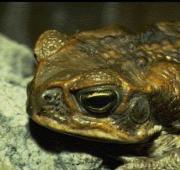 The marine toad (also known as the cane toad or the giant toad) is a species or terrestrial (land-dwelling) toad that is natively found throughout Central and South America. The marine toad is one of the world's true toads and is often used to eradicate pests from sugar-cane (hence it's name).
The marine toad (also known as the cane toad or the giant toad) is a species or terrestrial (land-dwelling) toad that is natively found throughout Central and South America. The marine toad is one of the world's true toads and is often used to eradicate pests from sugar-cane (hence it's name). The marine toad is generally found in the subtropical forests of Central and South America, where despite it's name, spends it's life entirely on the land. The marine toad has also been introduced to non-native regions as a form of pest control for crops.
The marine toad is generally found in the subtropical forests of Central and South America, where despite it's name, spends it's life entirely on the land. The marine toad has also been introduced to non-native regions as a form of pest control for crops.


As with numerous other toad species, the marine toad is a carnivorous animal, primarily surviving on a diet of insects. Due to their large size however, marine toads have also been known to hunt slightly bigger animals including rodents, reptiles, birds and even other amphibians.
Due to it's relatively small size, the marine toad is preyed upon by a number of different species within it's natural environment. Caimans, snakes, rats, eels, opossums and various birds of prey are all predators of the marine toad.
Like other amphibians, the marine toad undergoes the incredible transformation from a water-bound tadpole to a ground-dwelling adult in a matter of months. Like it's adult counterpart, the marine toad tadpoles are also highly toxic to any animal that eats them.
Today, the marine toad populations are thriving around the world due to the artificial introductions of the marine toad to many islands in the 1900s. Since then, the marine toad has become a pest in many of these countries as their ruthless nature poses a serious threat to native species.

